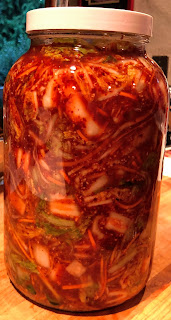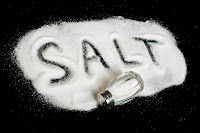Doshers Spicy Kimchi (V1)

Let's talk about the amounts used in the recipe. Is it really a recipe? Not sure I would classify this as a time-tested recipe. I used all the ingredients I thought would make a great Kimchi and eyeballed all the amounts. The quantities were based on two things which were taste and appearance. When I say appearance, I mean literally adjusting the ratios of the veggies based on what they looked like. And yes, I actually weighed and recorded everything. Don't get me wrong, I'm not saying you need to use the exact amounts I used, but this certainly makes a good starting point for most. It gives me a point of reference to look back upon to either replicate or modify. As of this writing, I haven't even tasted the fermented product yet. I'll write a review later on.

Beginning with the Napa Cabbage. I estimated that I needed between 6-7 lbs of cabbage to fill a one-gallon jug. To split these babies up and preserve the inner leaves, I suggest taking a sharp knife and cutting down a few inches; then, split them open using your hands.
Note: I set aside about 3 leaves that were not perfect, which will make a great first follower. I discarded the bad ones………maybe two of them.

This is a shortened version of what Sandor Katz wrote, and he was quoting someone else, but Kimchi brines are typically 15% of salt by weight and brined for 3-6 hours and conversely 12 hours for a 5-7% brine.

I chose the minimum about of salt at 5% for 9 hours. Here are my thoughts for using 5% and the shortened time of 9 hours. Salt percentages will either speed up or slow down fermentation. The more salt you add, the slower the fermentation, and the opposite are true too. The same thing applies to temperatures, and if you ferment in a warmer environment, the process will be faster. Some people who think outside the box will use more salt in the summertime to slow down the process and less salt in the winter. Since it's summertime by me and I have my Air Conditioner on full blast at a constant temp of 60 f I added less salt.

Make sure to weigh down the cabbage too. I used ZERO water and Redmond salt. How to make a 5% brine? If you have 1000 ml of water, multiply that by 5% or .05 = 50 grams of salt needed. I would highly suggest you dissolve the salt in hot water first. Make adjustments necessary but make sure the brine is cool before adding the cabbage. I have ZERO water ice-cubes, so I could cool everything off fast. I think I ended up needing about 11 liters of water (about 3 gallons).


I used a daikon radish for my Kimchi, but I have seen Kimchi recipes that have used Kohlrabi, Korean Radish, and Jicama. Julienne everything with a knife or a mandolin.


Oh, I forgot to mention to buy organic veggies. Way better for fermenting for apparent reasons. Anyhow, do the same with the carrots.
I chose an Asian pear instead of sugar, but you can use whatever you want. Regular pears work, too, of course. Anyhow, slice to any desired shape you want, and I use tiny thin slices.

Using Sweet Rice Flour as a slurry base is common in Kimchi, although not needed. Take one cup of water and heat up first, just a bit. Take 1/4 of Sweet Rice Flour, one cup of water, add to a one-pint jar, cover, and shake. Add this to the other cup of water simmering on the stove. Make a slurry.



You cannot make Kimchi without garlic, and I love garlic. Loving the ginger and onions too.


Everything into the food processor to form a paste. Add the now cooled slurry mixture too. I forgot to take the picture but add the Koran Chili flakes to this mixture.
As an optional ingredient to give it that funk taste, we all love and know (Red-Boat). This fish sauce is on the spendy side compared to others is worth buying. You can use whatever you want and don't forget it's optional. Add this to the food processor too.
 This is a must for spicy Kimchi!!! I have both the powdered and the flake versions. Damn, so good!!! Some people also use hot pepper flakes and the Koran stuff, but it's unnecessary IMO. Don't forget I used 80 grams split, and I tossed 40 grams into the cabbage first. I thought this would be an excellent way to ensure that every crevice hot some spice.
This is a must for spicy Kimchi!!! I have both the powdered and the flake versions. Damn, so good!!! Some people also use hot pepper flakes and the Koran stuff, but it's unnecessary IMO. Don't forget I used 80 grams split, and I tossed 40 grams into the cabbage first. I thought this would be an excellent way to ensure that every crevice hot some spice. After the 9 hours brine bath, I place cabbage in the colander to drain. This colander is 24 inches across. It's huge!!! I would recommend at least 30 minutes. Note: save about 2 cups of the brine if you need it to top off jars.

Pull one out and slice down the middle…. Slice across to make bite-size pieces. Give the cabbage a taste. I think the salt % is just about perfect. I used just about the whole cabbage except for the hard piece at the end…….maybe an inch I threw away.

I cut the green onion at about 2-3 inches and sliced it down the middle. My favorite way to slice them.
This is not the usual way, but this is my way!!!! Toss all the veggies in the bowl and the 40 grams of Korean Chili flakes and toss well. Don't over-handle the cabbage….. you're not making sauerkraut.
Toss in the slurry and mix very well, making sure not to overhandle the cabbage. I forgot to take a picture of the slurry being added and incorporated into the big bowl…… I only have two hands, you know.


Starting loading this baby up….Packing it down.

Push everything below the brine. Place reserved cabbage leaves on top, making sure they are used in such a way to force everything below the brine.


Seal it up with a tight finger seal……


It's been 4 days, and I needed to check on the Kimchi. The first 3 days, there was not much activity, and my A/C was on, and the house was about 60 f. This morning it was bubbling away, though.

Very interesting so far…..
The smell is excellent.

After the taste, it was just ok….nothing to write home about. The funk means the fish sauce is just barely coming through. The garlic levels were excellent (ok). As you can tell from the Ph. Reader, it's barely below Ph. 4.6. It needs more acidy before it will be ready, and I'm guessing it will be ready somewhere below Ph. 4.20.

I had to set them outside in the garage for 36 hours because my house was too cold. I have my A/C running, and it's about 56-60 degrees. The garage has been a comfy 66 degrees for a few days. Today though it will be closer to 90 f outside, I brought them back into the house for the night.


It's all about taste in the end. It's all done, and it tastes great. A Ph. of 4.12 seems to give a nice to me. I'll provide a review at the bottom.
Note: Once your fermentation has hit its sweet spot and you are satisfied, refrigerate to stop the fermentation process.
Review- First, let me say that it's pretty damn good. What would I change? I would subtract about 20-25% of the veggies or add more cabbage. I would double up on the pear or add some sugar. Maybe 15% more garlic. Instead of 1/4 cup of Fish Sauce, I would use perhaps a 1/3 cup. I would also increase the brine from 5% to 7% and from 9 hours to 12 hours. This batch yielded 8 pints.
Note: Other Kimchi's I've eaten have been much hotter, and I am assuming they used hotter peppers in addition to the Korean Red pepper.
Update: When I made the Bok Choy Kimchi, I found the 7% brine at 12 hours perfect. Some of the other changes were better too.
HOW DO I USE MY KIMCHI...
On HOT WINGS
ON BURGERS
THE BURGERS WERE SV TOO
And a different version too... Saute Onions, Garlic, peppers. Toss in Kimchi with some additional Korean Pepper Flakes and ground-up peanuts. Use this on a burger!








































Comments
Post a Comment